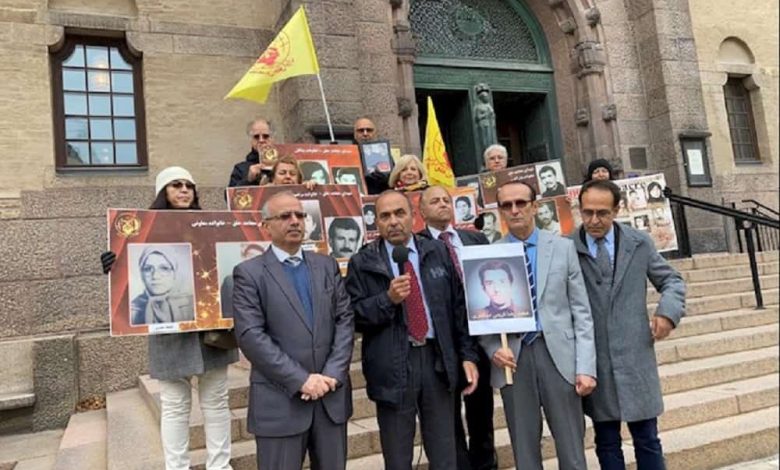Witnesses in Swedish Trial Affirm Need for Int’l Action on Iran’s 1988 Massacre

stockholm-sweden-iranians-1988massacre-min
Written by
Amir Taghati
This week, Iranian expatriates in Sweden continued a series of public demonstrations calling for the international prosecution of leading figures in the Iranian regime, including Supreme Leader Ali Khamenei and his new President Ebrahim Raisi.
Nearly all of the demonstrations in Stockholm have coincided with separate sessions in the trial of Hamid Noury, a former prison official who was arrested upon traveling to Sweden in 2019, with authorities citing the principle of “universal jurisdiction” to justify the action.
The charges against Noury including war crimes and mass murder, stem from his role in the torture of political prisoners at Gohardasht Prison before and during the massacre of 1988, which claimed the lives of over 30,000 political prisoners across the country, over the course of about three months.
The Stockholm demonstrations and accompanying statements from the Iranian Resistance highlight that Noury’s role in the massacre was minor compared to that of Ebrahim Raisi, who served as one of four officials on the Tehran “death commission” that oversaw the interrogation and execution of dissidents.
Iranian stands trial in Sweden for 1980s war crimes
The massacre grew out of a fatwa from the regime’s founder and first supreme leader, Ruhollah Khomeini, and it took particular aim at the People’s Mojahedin Organization of Iran (PMOI/MEK). The religious edict in question described members of the MEK as being inherently guilty of “enmity against God,” and it urged authorities to execute them promptly and without opportunities for clemency.
In line with that recommendation, Raisi’s death commission generally asked only one question of political prisoners in order to ascertain whether or not they supported the MEK. Many refused to denounce the MEK and gave their lives for freedom.
This account of the massacre has been repeatedly corroborated in the context of Noury’s trial. Dozens of witnesses are being given an opportunity to speak about their experiences as survivors of the massacre or as family members of victims in a trial that is not expected to conclude until April.
Recent sessions have featured former political prisoners and MEK members, and supporters who lost multiple family members during the massacre. One witness, the MEK member Khadijeh Borhani noted that by the end of the 1988 massacre, she was the lone survivor among her immediate family. Four of her siblings were killed in earlier crackdowns on dissent, and the remaining two were executed by hanging during the massacre. Borhani attributed both her parents’ untimely deaths to the grief and shock associated with the regime’s attacks on their family, and she said that while her mother was in the custody of security forces, “the prison guards broke her legs with thick metal bars.”
Another witness, Seyyed Hossein Seyyed Ahmadi, also recalled his mother being attacked by prison authorities, but in her case, it was not because she herself was detained. Instead, she was beaten and had her arm broken because she complained about the severe mistreatment of another of her sons, Mohsen. Though initially sentenced to only one year in prison, Mohsen remained detained indefinitely because he refused to denounce the MEK. Seyyed Ahmadi explained that about 100 of the MEK supporters were given minor sentences for their political activities in 1980, only to remain in prison and ultimately be executed as part of the 1988 massacre.
The 1988 Massacre of Political Prisoners in Iran: Eyewitness Accounts, Hossein Seyyed Ahmadi
Many witnesses emphasized the status of the 1988 massacre as an ongoing crime against humanity, noting that families inside Iran remain under pressure not to speak about the incident while lacking closure in the form of information about their loved one’s final resting places. PMOI activists have identified the locations of mass graves in approximately three dozen cities, but regime authorities have sought to cover up evidence of the massacre by destroying those sites and building upon them.
Human rights groups like Amnesty International have issued various statements over the years indicating that this pattern of destruction threatens to undermine any future investigation aimed at establishing the true scale and precise details of the 1988 massacre. While echoing this sentiment and affirming the need for a formal UN-led commission of inquiry, the Iranian Resistance has also emphasized that the outcome of any such investigation should be the international prosecution of Ebrahim Raisi and other known perpetrators of crimes against humanity in Iran.
Witnesses in Swedish Trial Affirm Need for Int’l Action on Iran’s 1988 Massacre

